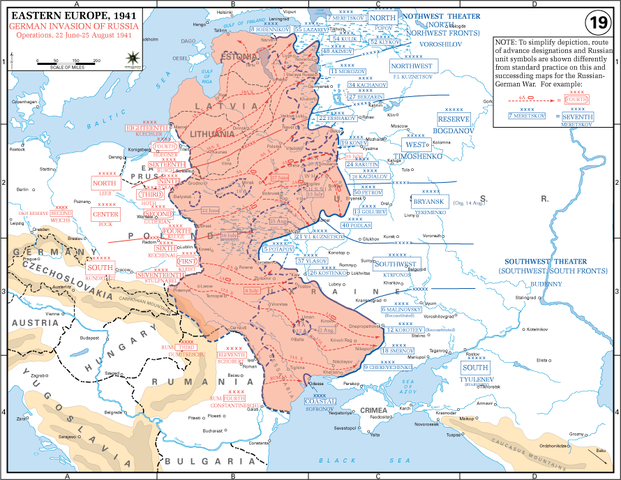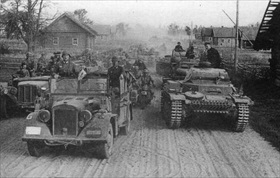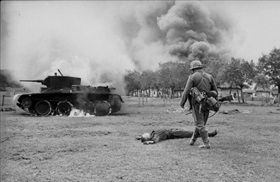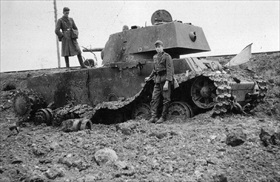HITLER PLOTS SOVIETS’ RUIN WITH OPERATION BARBAROSSA
Berlin, Germany • December 18, 1940
On this date in 1940 in Berlin, one day before receiving the credentials of the new Soviet ambassador to Germany, Adolf Hitler signed Fuehrer Directive 21, Operation Barbarossa (Unternehmen Barbarossa), thereby initiating the secret preparations and military operations that led to the Axis invasion of the Soviet Union on June 22, 1941. The directive stated that Germany’s armed forces (or Wehrmacht) must be prepared, even before the conclusion of the war with England (which had entered the war against Germany 16 months earlier), to annihilate the Soviets militarily in a lightning campaign. For that to happen the plan called for the attack along an 800‑mile/1,288‑km front stretching from the Baltic to the Black Seas, using more troops (3 million but eventually swelling to 4.5 million), artillery pieces (46,000), tanks (3,350), aircraft (4,389), and transport horses (750,000) ever to be unleashed on an opponent. On the eve of the 1941 invasion Hitler told members of the Oberkommando der Wehrmacht (German High Command): “Your armies will shatter the Russian colossus. It will be a hard fight. The Asiatics are cruel and cunning, but you will meet them with a determination as hard and cold as ice. Only one people will come out of this alive—our people.” He forecast a German victory inside 3 months.
Operation Barbarossa is important for three reasons. First, it was the single largest land battle in history. Secondly, had Barbarossa succeeded, the Third Reich would have scooped up huge tracts of the Soviet Union’s heavily populated and agricultural heartland, its oil-rich Caucasus, and the greater part of its strategic industries. The Nazis believed that it was only by grabbing the human and raw material and finished resources of a large economy like the Soviets’ could Germany compete, even survive as a great power, against other great economic powerhouses, especially the United States, which for the time being remained neutral in the global competition between Western democracies and totalitarian states represented by Germany, Italy, and Japan, which formed the principal Axis Powers.
Thirdly, the botched outcome of Operation Barbarossa marked the beginning of the end for Hitler’s Germany, militarily, geopolitically, and economically. The utter vastness of the Eastern Front stretched the Wehrmacht to the breaking point with serious logistics problems, weather-related issues (heavy rains followed by arctic cold), lack of winterized equipment, and a huge erosion over time in critical war matériel, personnel strength, and home front morale. In German casualties alone, 95 percent occurred on Soviet soil between 1941 and 1944. Notable Wehrmacht failures to capture and hold the Soviet breadbasket of Ukraine and seize major centers of population and industry like the Soviet capital Moscow, Stalingrad (today’s Volgograd) on the Volga River, and Leningrad (today’s St. Petersburg) on the Baltic coast drove up the casualty count on both sides. Sixty-five percent of all Allied military casualties were incurred by the Soviets either in trying to expel and destroy Axis enemy forces or in German POW camps, where most of the 3 million Soviet prisoners were deliberately starved to death as part of the Nazis’ Hungerplan (Starvation Plan). Devised by the Ministry for Food and Agriculture in December 1940, the plan to mass murder Soviet combatants and civilians alike in order to feed the invading German Army as well as the population back home was developed concurrently with planning Operation Barbarossa. Although food rationing in Germany had been introduced as early as August 1939, starting in April 1942 rations and options across the major food groups (grains, meat, fats, and dairy) were repeatedly cut ever more sharply as the nation’s Eastern Front misfortunes rapidly accelerated. By the end of the war bread and potatoes accounted for over 90 percent of German consumers’ daily intake.
![]()
Opening Phase of Operation Barbarossa, June–August 1941
 |
Above: Operation Barbarossa, unleashed in the early morning hours of June 22, 1941, was the codename for Germany’s invasion of the Soviet Union. The high-stakes gamble marked the end of the Nazi-Soviet Nonaggression Pact of August 1939 and the start of the pivotal phase in deciding the victors of the war in Europe. Germans of every stripe reveled in the moment: their nation controlled all of Europe from the Pyrenees to the Soviet frontier, a situation virtually unprecedented in history. During the first few months of Operation Barbarossa, when the Wehrmacht’s three-prong Russian campaign was wildly popular inside and outside the armed forces and the Soviet Union appeared headed for collapse, Germans won resounding victories and occupied some of the most important economic areas of that country. Germany’s Blitzkrieg approach to warfare in the East included genocidal practices to decimate the “racially inferior” Slavic population through planned mass starvation, after which German immigrants would be encouraged to resettle and exploit the rich agricultural and mineral resources of the emptied and conquered areas for the benefit of the Greater German Reich.
 |  |
Left: The 3rd Panzer Group under Col. Gen. Hermann Hoth, part of Field Marshal Fedor von Bock’s Army Group Center (Heeresgruppe Mitte), rolls through present-day Belarus near Pruzhany, June 1941. Army Group Center, one of three German armies attacking the Soviet Union, encircled Red Army forces around the Byelorussian (Belarus) capital Minsk, a key strategic railway junction and a defensive position on the main road and rail line to Moscow, the Soviet capital. During the Battle of Białystok–Minsk, Army Group Center threw back all major counterattacks and breakthrough attempts, killing and capturing 341,073 Soviets and advancing into the Soviet Union so quickly that many observers believed the Germans had effectively won the war.
![]()
Right: Soviet equipment that fell into German hands in the early days of Operation Barbarossa. According to Soviet archives, the Red Army lost 20,500 tanks and 21,200 aircraft between June 22 and December 5, 1941. Out of a jaw-dropping 4.7 million Soviet casualties, irrecoverable manpower losses were over 3.1 million, of which over 2.3 million persons were listed as missing in action. German equipment losses were put at 3,827 aircraft and between 2,464 and 2,839 tanks. German manpower losses per army (Heer) medical reports were 802,458 killed, wounded, or missing in action and (according to Red Army reports) 11,000 prisoners of war.
 |  |
Left: German infantryman in front of fallen Soviet tank solder and burning BT‑7 light tank in the southern Soviet Union during the early days of Operation Barbarossa, June 1941. Field Marshal Gerd von Rundstedt’s Army Group South’s principal objective was to capture Ukraine and its capital Kyiv (Kiev). Ukraine was a major center of Soviet industry and mining and had the good farmland required for Hitler’s plans for Lebensraum, or living space. (Pflanzenraum, or growing space, for gaining new agricultural and mineral resources to exploit along with increased colonization possibilities would have more accurately explained the German notion of Lebensraum.) The successful encirclement of Soviet troops in the vicinity of Kyiv (the First Battle of Kyiv) ran from August 23 to September 26, 1941, and was the the greatest feat of arms in the history of warfare. Soviet losses were 700,544 men.
![]()
Right: German soldiers with a destroyed Soviet KV‑1 heavy tank near Kaunas, the second-largest city in Lithuania, June 1941. The tank may be one of over 700 tanks destroyed during the Battle of Raseiniai (June 23–27, 1941) by Army Group North, under Field Marshal Wilhelm Ritter von Leeb, en route to Leningrad. The result of the battle was the almost complete destruction of Soviet armored forces of the Northwestern Front, which was involved in heavy fighting in the Baltic Republics and on the approaches and the outskirts of Leningrad, the Soviet Union’s second-largest city.
History Channel’s Operation Barbarossa, the Invasion of the Soviet Union, June 22 to December 5, 1941
![]()

 History buffs, there is good news! The Daily Chronicles of World War II is now available as an ebook for $4.99 on Amazon.com. Containing a year’s worth of dated entries from this website, the ebook brings the story of this tumultuous era to life in a compelling, authoritative, and succinct manner. Featuring inventive navigation aids, the ebook enables readers to instantly move forward or backward by month and date to different dated entries. Simple and elegant! Click
History buffs, there is good news! The Daily Chronicles of World War II is now available as an ebook for $4.99 on Amazon.com. Containing a year’s worth of dated entries from this website, the ebook brings the story of this tumultuous era to life in a compelling, authoritative, and succinct manner. Featuring inventive navigation aids, the ebook enables readers to instantly move forward or backward by month and date to different dated entries. Simple and elegant! Click 











